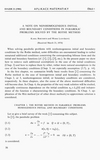Article
Full entry |
 PDF
(2.0 MB)
Feedback
PDF
(2.0 MB)
Feedback
 PDF
(2.0 MB)
Feedback
PDF
(2.0 MB)
Feedback
Keywords:
Rothe method; non-homogeneous initial and boundary conditions; weak solution
Rothe method; non-homogeneous initial and boundary conditions; weak solution
Summary:
When solving parabolic problems by the so-called Rothe method (see K. Rektorys, Czech. Math. J. 21 (96), 1971, 318-330 and other authors), some difficulties of theoretical nature are encountered in the case of nonhomogeneous initial and boundary conditions. As a rule, these difficulties lead to rather unnatural additional conditions imposed on the corresponding bilinear form and the initial and boundary functions. In the present paper, it is shown how to remove such additional assumptions in the case of the initial conditions and how to replace them by simpler, more natural assumptions in the case of the boundary conditions. In the last chapter applications and convergence of the Ritz method (or of other direct methods) to approximate solution of the originating elliptic problems is considered.
References:
[1] Rektorys K.: On Application of Direct Variational Methods to the Solution of Parabolic Boundary Value Problems of Arbitrary Order in the Space Variables. Czech. Math. J. 21 (96), 1971, 318-330. MR 0298237 | Zbl 0217.41601
[2] Kačur J.: Application of Rothe's Method to Nonlinear Evolution Equations. Matem. časopis SAV 25 (1975), No 1, 63-81. MR 0394344 | Zbl 0298.34058
[3] Kačur J., Wawruch A.: On an Approximate Solution for Quasilinear Parabolic Equations. Czech. Math. J. 27 (102), 1977, 220-241. MR 0605665
[4] Nečas J.: Les méthodes directes en théorie aux équations elliptiques. Praha, Akademia 1967.

